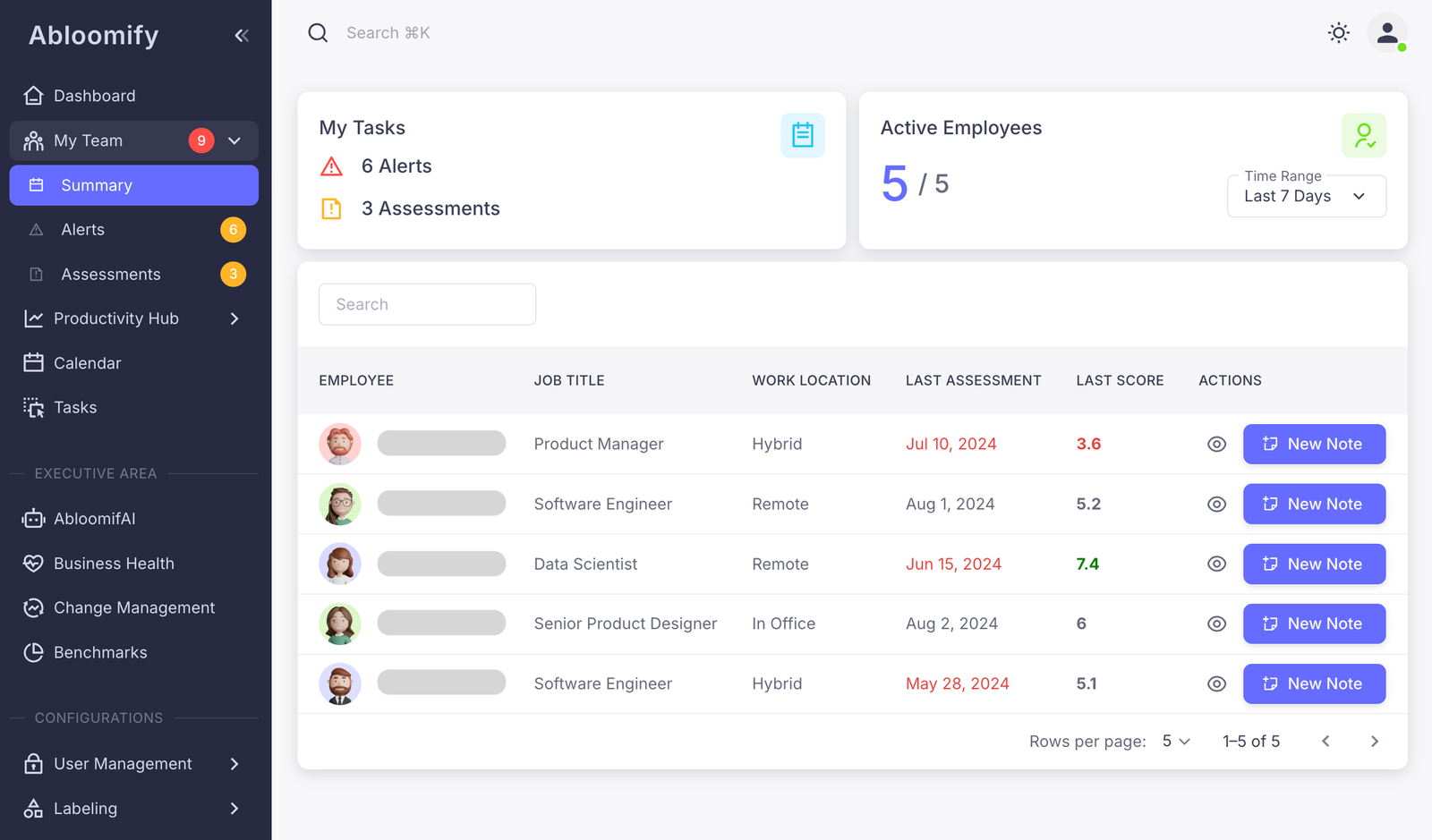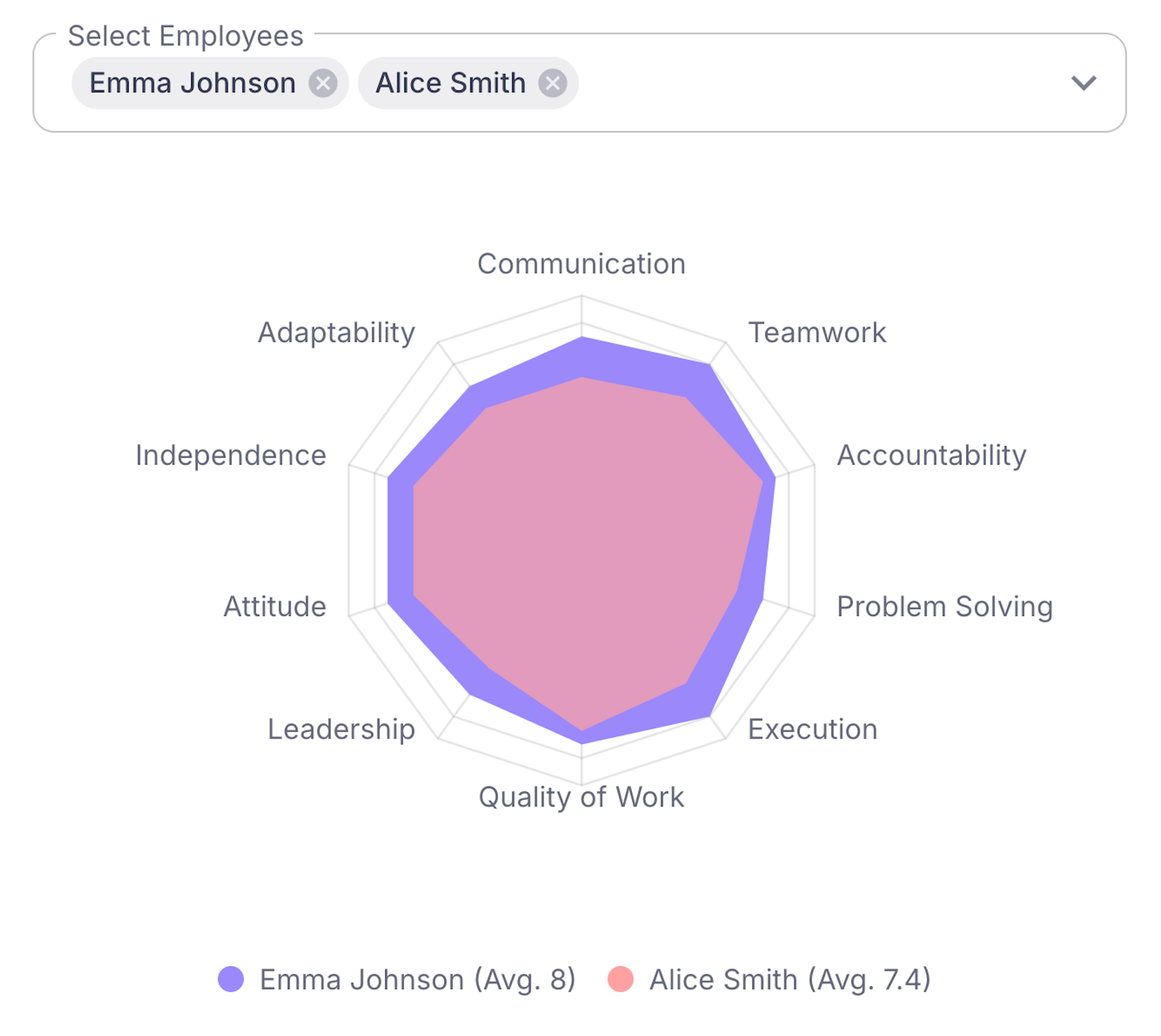Performance management strategies are critical for developing high-performing teams, especially within tech companies. This article delves into various strategies that leverage AI and data-driven insights to enhance productivity and efficiency. Whether managing remote or hybrid teams, understanding the right strategies can significantly impact your organization’s success.
Understanding Performance Management
Performance management is crucial for aligning workforce activities with the strategic goals of an organization. It encompasses continuous processes that ensure employees’ output and goals are in sync with the company’s objectives. Effective performance management doesn’t just aim at pinpointing gaps, it transforms these observations into growth opportunities. It directly impacts efficiency and employee morale.
Proper management strategies act as catalysts for productivity and engagement. By aligning everyone on the same path, inefficiencies can be recognized and rectified. Moreover, employees who understand their role in achieving the company’s mission tend to be more motivated and committed.
Traditional strategies typically focus on annual reviews, peer feedback, and structured goal-setting. However, these methods have their limitations. Over time, rigid processes often fail to capture real-time developments. Modern performance management leverages technology, injecting fluidity and adaptability into the system.
To illustrate how traditional strategies can be upgraded, consider the following enhancements:
- Real-time feedback: Encourages ongoing dialogue, allowing managers to offer guidance when it’s most needed.
- Goal tracking tools: Enable employees and managers to monitor progress dynamically, fostering a sense of achievement and involvement.
- Data analytics: Offers insights into performance trends, helping leaders make informed decisions.
Technology has enabled these improvements, making the performance review an ongoing narrative rather than a static report card. Modernizing these methods aligns closely with workforce analytics trends. More insights on these innovative strategies can be found in harnessing AI to optimize workforce performance.
AI-Powered Performance Assessment
Artificial intelligence is reshaping how performance assessment unfolds across tech-driven organizations. By leveraging AI, performance evaluations are becoming more continuous and data-driven, offering valuable insights into employee productivity. AI tools can now analyze patterns in real-time, alerting managers to productivity trends and potential performance dips.
These advanced systems often use algorithms to identify performance metrics, track achievements, and flag anomalies. This positions leaders to make data-backed decisions swiftly. Notably, some AI solutions also automate routine managerial tasks, such as meeting scheduling, thus granting leaders more time to focus on strategic initiatives.
However, it’s crucial to evaluate the implications of these tools. While continuous monitoring may enhance productivity, it carries the risk of employee burnout. The constant digital oversight can be perceived as intrusive, leading to stress and fatigue. Thus, maintaining transparency with employees about how AI impacts their work can foster trust and minimize negative reactions.
To mitigate these risks, organizations should consider:
- Implementing periodic human-driven assessments to complement AI findings.
- Ensuring AI-driven insights are used to support, not replace, human intuition.
- Providing employees with regular feedback and creating open channels for discussion.
- Adjusting AI parameters to align with individualized work habits and preferences.
Balancing the robust capabilities of AI with the human element is crucial. Leaders can follow guidance on unleashing productivity and leadership with AI to optimize these tools effectively within their organizations, propelling both performance and morale forward.
Data-Driven Insights for Workforce Planning
Data plays a pivotal role in workforce planning and management. It provides leaders with the clarity needed to make informed decisions. When used effectively, data transforms workforce planning into a streamlined process that enhances productivity and optimizes resources.
Several tools assist in data-driven workforce planning, including those that specialize in:
- Capacity Planning: Data insights help forecast staffing needs by analyzing historical work patterns and projected demand.
- Workload Balancing: Advanced analytics distribute tasks effectively, preventing employee burnout and ensuring efficient use of workforce talents.
- Succession Planning: By assessing performance data, organizations identify potential leaders and future-proof operations.
Platforms offer insights on flexible work models that support both remote and hybrid teams. These platforms provide detailed analytics on team engagement, productivity, and work preferences.
For instance, some platforms monitor employee activity levels, providing feedback on optimal work conditions. These insights are crucial for creating environments that maximize team outcomes without impacting morale. Additionally, they help align company goals with workforce capabilities, ensuring strategic fit and agility. This analytical approach is detailed further in our guide on unlocking the power of workforce analytics.
Data-driven strategies in workforce management aren’t just about crunching numbers. They empower leadership to cultivate an environment that nurtures talent and drives innovation. As organizations continue to adapt, leveraging these insights becomes not just advantageous but necessary for sustainable growth.
Implementing a Performance Management Framework
Implementing a standardized performance management framework offers a clear roadmap for assessment. By detailing criteria, businesses can streamline team evaluations and enhance productivity. A 10-category assessment framework for performance reviews provides a structured approach to evaluation. This method ensures consistent evaluations across all departments.
The benefits of this structured approach include:
- Alignment with organizational goals, ensuring everyone is on the same page.
- A clear understanding of performance expectations for employees, reducing ambiguity.
- Consistency in evaluations, fostering fairness and transparency.
Alongside structured evaluation frameworks, integrating AI into the process can enhance outcomes. AI-powered career path planning provides dynamic insights tailored to individual employees. This capability enables leaders to align employee growth with business objectives more effectively.
For instance, AI-driven recommendations can identify skill gaps and offer targeted development solutions. Employees receive suggestions for advancing their skills aligned with their career goals. This integration not only boosts team efficiency but also keeps individuals engaged and motivated.
Additionally, managers access data-driven insights to make decisions about team structure and responsibilities. Incorporating AI into performance management further supports harnessing AI to optimize workforce performance. This synergy between structured frameworks and advanced technology sets the stage for improved productivity.
Focusing on standardized frameworks and AI integration facilitates a robust performance management strategy. Such strategies ensure both leadership and team members have the tools needed for success.
Optimizing Change Management
Change management plays a crucial role in refining performance strategies. As leaders in the tech world, navigating the complexities of new processes or technology is essential for optimizing productivity. Successful change management hinges on understanding its impact, ensuring seamless integration into daily operations.
To measure the impact of changes, tools such as workforce analytics are invaluable. These tools allow leaders to assess employee performance metrics, identify areas for growth, and provide real-time insights into the efficacy of implemented changes. By using such tools, businesses can gauge if new technologies are enhancing efficiency or if they’re causing disruptions.
Optimizing technology use starts with identifying which tools genuinely contribute to your team’s objectives. To reduce wasted software spend, consider the following tips:
- Conduct a thorough software audit to focus on high-impact tools.
- Seek employee feedback to understand which tech solutions empower them the most.
- Foster a culture of continuous learning to maximize the utility of existing software investments.
Solutions offered by leading platforms, like those discussed in performance management for software companies, can aid this process. These solutions help adapt to changes swiftly without adverse effects on performance, thus mitigating potential disruptions. By approaching change management thoughtfully, firms can harness technology effectively, aligning it with overall business strategies and minimizing unnecessary costs. This lays a firm foundation for strategic improvements, setting the stage for sustained growth and success.
Ensuring Privacy in Performance Management
Striking a balance between performance monitoring and employee privacy is critical. Transparent practices can nurture trust, transforming interactions into constructive dialogues. To achieve this, a privacy-first design should be a fundamental part of any performance management strategy.
Building trust begins with how data is handled:
- Gather data only when it’s necessary and beneficial to both employees and the organization.
- Ensure employees understand what data is collected and how it’s used.
- Offer employees control over their data, fostering a sense of agency and trust.
Companies should prioritize aggregate insights over invasive tracking. This allows teams to focus on the bigger picture, enhancing productivity while respecting individual boundaries. Abloomify, for example, emphasizes using data insights while safeguarding personal privacy. Through this approach, performance improvements emerge without compromising individual rights. More details can be accessed in their workforce analytics insights.
Leaders play a pivotal role in promoting privacy-first practices. By being transparent and communicative about data policies, they set a precedent for others. Regularly updated privacy agreements and continuous training reinforce these practices, creating an environment where employees feel valued and protected.
Quality performance management doesn’t have to infringe on privacy. With thoughtful implementation, companies can secure trust, drive productivity, and cultivate a respectful workplace culture. By doing so, organizations not only secure the present but lay a strong foundation for future transformations and innovations.
Improving Team Dynamics with Coaching
Enhancing team dynamics through coaching is a strategic move for leaders aiming to build high-performing teams. Coaching fosters a culture where actionable feedback becomes a tool for growth. It enables team members to gain insights into their work, identify areas for improvement, and harness strengths effectively.
Focusing on key strategies can unlock the full potential of your team:
- Personalized Coaching: Tailor sessions to individual strengths and weaknesses. This individual attention helps in setting realistic goals and achieving them.
- Real-Time Feedback: Encourage a system where feedback is immediate and relevant. This prevents issues from festering and allows for quick adjustments.
- Empowerment Through Accountability: Hold individuals accountable without micromanaging. This creates ownership and inspires individuals to take charge of their contributions.
- Consistent Development Plans: Set up regular check-ins and development plans. This ensures that progression is tracked and celebrated appropriately.
The benefits extend beyond mere performance enhancement. Streamlined communication and effective decision-making processes lead to a more cohesive team environment. Team members feel heard, valued, and motivated to contribute positively. The use of collaborative platforms and tools also ensures that everyone is aligned and working towards common goals.
In fostering superior team dynamics, workforce analytics can unlock productivity and leadership. Data-driven insights provide another layer of understanding, enabling coaches to optimize their strategies. By leveraging these capabilities, teams can achieve breakthroughs and elevate their overall performance levels.
Choosing Abloomify for Your Business
When looking for ways to refine performance management strategies, businesses can significantly benefit from choosing an AI-powered platform. This approach streamlines and optimizes workforce processes, ensuring you are always one step ahead. Abloomify’s suite of tools offers unique advantages that go beyond traditional methods.
One key benefit is its capability to intelligently analyze workforce data. By implementing rigorous analytics, it provides insights that can help identify areas for improvement and growth. This allows companies to make informed decisions, maximizing productivity and efficiency. Furthermore, it offers predictive insights that prepare organizations to adapt to future challenges, making your business agile and resilient.
Retention of top talent is another crucial element in modern business optimization. Abloomify’s AI tools support employee engagement by fostering an environment of transparency and communication. This leads to higher job satisfaction and reduced turnover rates. Here’s how it helps:
- Personalized feedback loops drive employee engagement.
- Goal alignment features ensure everyone is on the same path.
- Real-time analytics provide actionable insights to enhance job satisfaction.
As the workplace continues to evolve, adapting to new technologies and methodologies becomes vital. Integrating such innovative solutions will give your company a competitive edge. For businesses seeking personalized solutions to elevate their workforce management practices, exploring AI-driven workforce management is the way to go. By understanding and leveraging the strengths of these multifaceted tools, leaders can secure their organization’s future growth and success. Contact Abloomify today for a tailored strategy that aligns with your unique business needs.
Final words
Incorporating innovative performance management strategies can significantly enhance team productivity and overall business success. AI-driven tools, like those offered by Abloomify, provide critical insights and sustainable growth opportunities. For leaders aiming to optimize their workforce, embracing these modern solutions is crucial. Consider partnering with Abloomify to leverage these strategies effectively.



